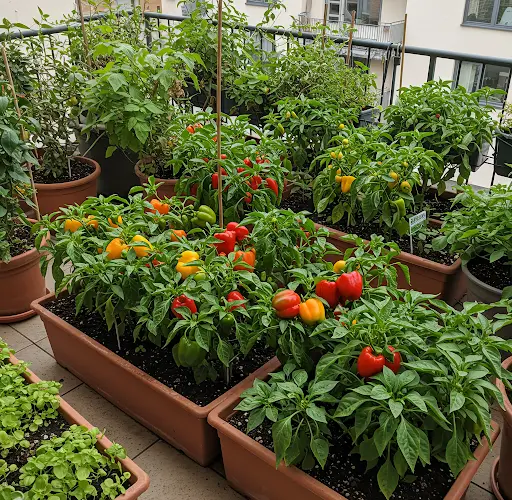The Secret to Growing Peppers with Many Fruits – Beautiful Heart-Shaped Peppers
Peppers are a favorite among home gardeners, not only for their delicious flavor but also for their stunning appearance, especially heart-shaped varieties. Whether you’re growing sweet or hot peppers, the right techniques can lead to a high yield and visually appealing fruits. This guide will take you through the secrets to growing peppers with an abundance of fruit, helping you achieve a beautiful, productive garden.
1. Choosing the Right Variety for High-Yield, Heart-Shaped Peppers
Different pepper varieties have different growth habits and fruit shapes. Selecting the right variety is the first step toward achieving a plentiful harvest.
Best Heart-Shaped Pepper Varieties:
- Sweet Heart Pepper: A sweet, crisp variety perfect for fresh eating.
- Mini Bell Peppers: Small, colorful, and perfect for container gardening.
- Pimiento Peppers: Classic heart-shaped variety with a mild, sweet taste.
- Sweet Chocolate Pepper: A unique brown-red pepper with high productivity.
- Habanada Pepper: A heat-free version of habanero with a sweet, fruity flavor.
2. Preparing the Perfect Soil for Pepper Growth
Peppers thrive in rich, well-drained soil with the right balance of nutrients.
Ideal Soil Mix:
- 40% Loamy Garden Soil: Provides structure and essential minerals.
- 30% Compost or Aged Manure: Supplies organic matter for continuous feeding.
- 20% Perlite or Sand: Improves aeration and drainage.
- 10% Coco Peat or Peat Moss: Helps retain moisture without waterlogging.
- Optimal pH Level: Maintain a soil pH of 6.0-6.8 for nutrient absorption.
3. Starting Peppers from Seeds for a Strong Crop
Starting peppers from seeds allows you to select the best plants for a productive season.
Seed Starting Tips:
- Start seeds indoors 8-10 weeks before the last frost date.
- Use a seed-starting mix to encourage strong root development.
- Keep temperatures between 75-85°F (24-29°C) for faster germination.
- Provide grow lights or a sunny windowsill for at least 12-16 hours per day.
- Transplant outdoors once seedlings are at least 6 inches tall and nighttime temperatures stay above 55°F (13°C).
4. Proper Spacing and Planting for Maximum Fruit Production
Peppers need space to grow strong roots and avoid overcrowding, which can reduce fruit production.
Spacing Guidelines:
- 18-24 inches apart for bushier varieties.
- 12-15 inches apart for smaller container varieties.
- Use raised beds or large pots for better root development.
- Plant in full sun (6-8 hours daily) for the best yield.
5. Watering and Mulching – Key to Healthy Peppers
Proper watering is essential to prevent stress and ensure high yields.
Watering Tips:
- Water deeply 2-3 times per week, depending on climate and soil type.
- Avoid overhead watering to prevent fungal diseases.
- Mulch with straw or wood chips to retain moisture and suppress weeds.
6. Boosting Pepper Growth with Proper Fertilization
Peppers require a balanced feeding schedule for continuous fruit production.
Best Fertilizers for Peppers:
- Nitrogen-Rich Fertilizer (Early Growth): Apply fish emulsion or compost tea.
- Balanced Fertilizer (During Flowering): Use a 10-10-10 NPK formula.
- Potassium and Phosphorus Boost (Fruit Development): Add banana peel tea or bone meal.
- Epsom Salt (Magnesium Source): A tablespoon per gallon of water improves leaf health and flower formation.
7. Training and Pruning Peppers for High Yield
Managing pepper plants properly can increase airflow, reduce disease, and enhance fruit production.
Effective Pruning Techniques:
- Pinch off early flowers to allow the plant to establish strong roots.
- Remove lower leaves to prevent soil-borne diseases.
- Support taller varieties with stakes or cages to prevent bending.
8. Encouraging Pollination for More Fruits
Without proper pollination, pepper plants may produce fewer fruits. Enhance natural pollination with these tips:
How to Improve Pollination:
- Attract Bees & Pollinators: Grow companion plants like basil, marigolds, and lavender.
- Hand Pollinate: Use a soft brush to transfer pollen between flowers.
- Gently Shake Plants: Helps distribute pollen naturally.
9. Protecting Peppers from Pests and Diseases
Keeping your pepper plants healthy ensures a successful harvest.
Common Pepper Pests & Organic Solutions:
- Aphids & Spider Mites: Spray neem oil or insecticidal soap.
- Cutworms & Caterpillars: Handpick and use organic Bt (Bacillus thuringiensis).
- Blossom End Rot: Prevent calcium deficiency by adding crushed eggshells.
- Powdery Mildew & Leaf Spot: Ensure good airflow and apply a baking soda spray.
10. Harvesting Peppers at the Perfect Time
Picking peppers at the right time ensures maximum flavor and extended fruit production.
When to Harvest Peppers:
- Sweet Peppers: When they reach full size and develop a rich color (red, yellow, or orange).
- Hot Peppers: Pick green for a milder taste or let ripen for extra heat.
- Use Sharp Scissors or Pruners to avoid damaging the plant.
- Harvest Regularly to encourage more fruiting.
Storage Tips:
- Store fresh peppers in the fridge for up to 2 weeks.
- Freeze chopped peppers for long-term use.
- Dry hot peppers for spice blends.
11. Succession Planting for Continuous Pepper Harvest
To enjoy peppers all season long:
- Plant new seeds every 3-4 weeks for a steady supply.
- Rotate pepper crops with beans or lettuce to replenish soil nutrients.
- Replenish soil with compost between planting cycles.
Conclusion
Growing peppers with an abundance of fruits, especially heart-shaped varieties, is easier than you might think. By choosing the right varieties, optimizing soil conditions, managing watering and fertilization, and ensuring proper pollination, you can enjoy a continuous harvest of beautiful, flavorful peppers. Whether you have a backyard garden, a terrace, or a small urban space, these tips will help you maximize your pepper production. Start planting today and get ready for a vibrant, productive pepper garden!



